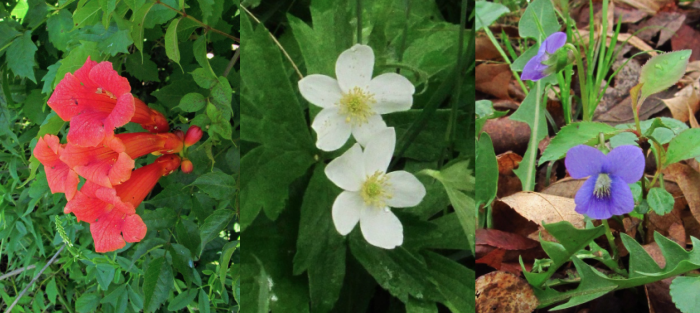Happy July 4 to the Bleeding Heartland community! In recent years, I’ve marked this holiday by posting Windsor Heights parade pictures or the names of state lawmakers who voted to legalize fireworks sales in Iowa.
Since Independence Day falls on a Wednesday this year, I decided to showcase Iowa wildflowers that display the colors on the American flag. The blossoms in the top image are trumpet vine, Canada anemone, and common blue violets. Follow me after the jump for 34 more species…
SPRING
Let’s start with some native plants that bloom in the spring. Click on any link for more information about and pictures of that flower.
Red: prairie smoke. I’m always excited to see the first of these blooming, usually in early May. What looks like a Dr. Seuss creation are the seed pods. The flowers are closed and initially point downward, then turn up before going to seed.
White: toothwort. These woodland plants typically bloom in April, sometimes in late March.
Blue: Virginia bluebells. These are prevalent in gardens as well as wooded areas.
Red: Toadshade trillium. These early spring bloomers are relatively rare and usually found in woodlands. The flowers never open all the way.
White: striped white violet. A separate species from the white variation of common blue violet.
Blue: common blue violet. Aside from dandelions, these are the most prevalent wildflowers in grassy lawns.
Red: wild ginger. You have to peek under the leaves to see these maroon flowers, pollinated by crawling insects.
White: shooting star. This rare species is mainly found on high-quality native prairies. While many plants have pink blossoms, white is also a common color variation.
Blue: dwarf larkspur. These bluish-purple flowers are also rare and found primarily in woodlands.
SUMMER
As the days grow long and hot, many more colorful flowers begin to bloom.
Red: wild red columbine. A popular garden plant, thanks to its stunning blossoms.
White: white avens. These woodland plants are easily overlooked. I just took this picture today; near the right side of the frame, you can see seed pods starting to form where the flowers have finished. Those will become burs that stick to fur or clothing.
Blue: Asiatic dayflower. These plants are not native to North America but escaped from many gardens and have become naturalized across Iowa.
Red: Oswego tea, also known as red bergamot or scarlet bee balm. Another garden escapee: these plants are native to eastern regions of North America but don’t really belong in Iowa.
A close relative of Oswego tea, called horsemint or bee balm or wild bergamot, is prevalent across Iowa in early to mid-summer.
White: Culver’s root. A prairie plant beloved by pollinators.
Blue: blue vervain. Usually found in native or restored prairies.
Red: trumpet vine. A favorite of ruby-throated hummingbirds. Some plants have orange rather than red blossoms.
White: Canada anemone. Can thrive in prairie or wooded habitats.
Blue: great blue lobelia. These plants thrive in a range of wet habitats; I took this picture four summers ago in a seep at Whiterock Conservancy.
Red: biennial gaura. Sometimes called biennial beeblossom because of its popularity with bees.
White: rattlesnake master. This prairie species was once considered useful for treating snake bites. The pink flowers in the background are winged loosestrife, one of my favorite summer wildflowers.
Blue: chicory. European settlers brought this plant to North America as a coffee substitute. You will see it blooming this time of year along many Iowa roadsides.
Red: royal catchfly. Although this plant is native to states south and east of Iowa, you may see it in prairie restorations here.
White: whorled milkweed. These prairie plants are much shorter than common milkweed and have smaller blossoms.
Blue: American bellflower. One of my all-time favorite woodland plants. Some years, they are already blooming by July 4, but I haven’t seen any in central Iowa yet. The flowers may be more purple than the blossom pictured here.
LATE SUMMER/AUTUMN
Red: swamp milkweed. Technically, these flowers are pink–but they are typically a very deep pink.
White: white snakeroot. These are common along wooded trails and harmless, as long as you don’t drink milk from cows that have been grazing on them.
Blue: wild blue sage, also known as pitcher sage. A relatively rare prairie species.
Red: Golden Alexanders gone to seed. These prairie plants have yellow flowers in the spring, but they turn red months later.
White: Indian pipe. Marla Mertz gave me permission to share her photograph of this unusual woodland species, which lacks chlorophyll.
Blue: tall blue lettuce, also known as blue wood lettuce. I’m always excited to see the first of these blooming near the Windsor Heights bike trail, and I hope last weekend’s flooding along North Walnut Creek didn’t wipe out the colonies.
Red: Jack-in-the-pulpit seed pods. These plants bloom in the early spring. The “jack” eventually develops into a green seed pod that turns bright red around September.
White: tall boneset. I usually need expert help to distinguish this species from late boneset. Two years ago, I was lucky to find this common buckeye butterfly sampling some tall boneset flowers.
Blue: bottle gentian. Wendie Schneider captured this gorgeous image of a bottle gentian plant on a Story County prairie last year. The flowers never open.




































2 Comments
A beautiful way to celebrate the Fourth!
Thank you.
PrairieFan Thu 5 Jul 7:52 PM
A beautiful way to celebrate the Fourth!
Thank you.
PrairieFan Thu 5 Jul 7:52 PM